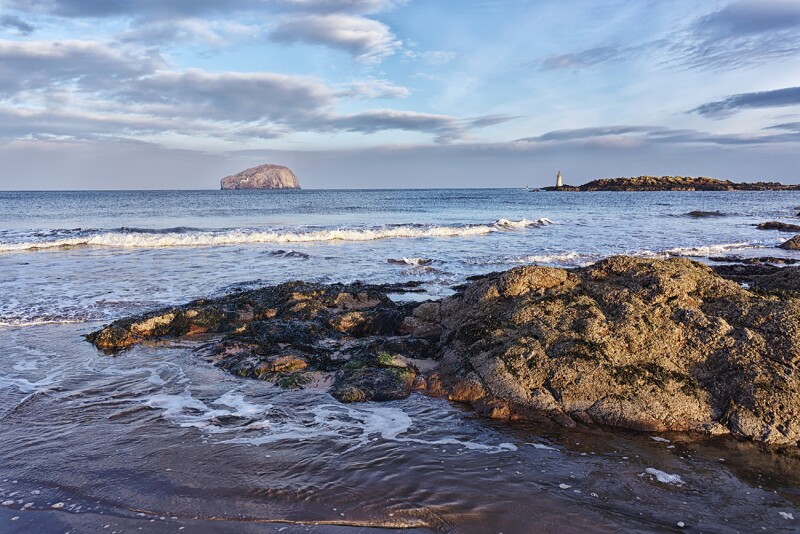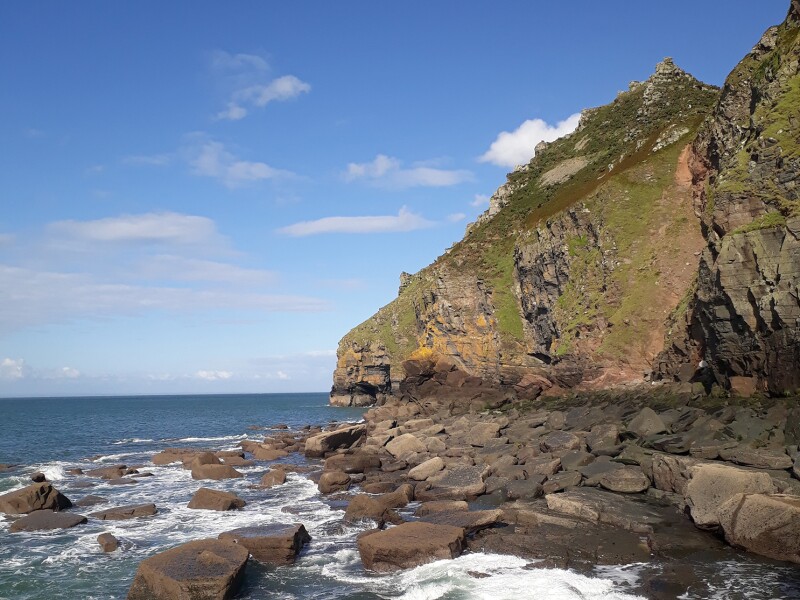The United Kingdom may not be your intuitive first pick for a beach escape, but the region is actually brimming with popular seaside retreats, from Bournemouth to Blackpool to Brighton. And for those who prefer more seclusion, there are plenty of hidden coastal havens, too, even if you have to dig a little to uncover the best of them. Indeed, the coastlines of England, Wales, Scotland, and Northern Ireland are blessed with wild and remote beaches that generously reward the effort to get there.
Take heed that most of these beaches don’t have lifeguards (so be wary of the potential for dangerous riptides) and that the weather can be as prone to misty mornings and chilly winds as sunshine, even during the height of the summer beach season. Then dust off your sturdiest beach shoes—as some clambering may be required—and set out to explore our picks for 12 of the best secluded and secret beaches in the United Kingdom.
Vatersay Bay
Vatersay, Outer Hebrides, Scotland
Connected to the island of Barra by a causeway, picture-postcard Vatersay is the most southerly inhabited island in Scotland’s Outer Hebrides archipelago (otherwise known as the Western Isles). Vatersay Bay is one of a handful of machair-backed, white-sand beaches on the tiny isle, but its waters are sheltered and safest for swimmers braving the cold of the jewel-blue Atlantic Ocean.
How to Get to Vatersay Bay: From Glasgow’s international airport, you can catch a connecting flight (via seaplane) to Barra. If you have a car, drive just over two hours from Glasgow to the resort town of Oban, and take the nearly five-hour-long car ferry to Barra. From Castlebay, the main settlement on Barra, it’s a short and scenic five-mile drive or cycle to Vatersay Hall Café, with its car park across the street from the beach.

Set at England’s most southwesterly point, on the Lizard Peninsula, the pebble beaches at Cadgwith Cove offer a tranquil retreat.
Photo by Jason Batterham/Shutterstock
Cadgwith Cove
Cadgwith, Cornwall, England
On Britain’s most southwesterly point, the Lizard Peninsula—on the sheltered English Channel—hosts several scenic beaches. For an especially tranquil stretch, consider the Lizard’s rockier east coast where the traditional fishing village of Cadgwith has two small pebble beaches separated by the Todden, a tiny rocky headland. Fishermen use the beach with the slipway, while swimmers head over to the eastern beach. Tip: The 300-year-old Cadgwith Cove Inn, perched above the small harbor, hosts traditional Cornish singers on Friday evenings.
How to Get to Cadgwith Cove: The closest major airport is in Exeter, a 2.5-hour drive away; access the beach via the parking lot on New Road, at the entrance to the village (it’s a 10-minute walk from there).
Priory Bay
Seaview, Isle of Wight, England
In the 19th century, Queen Victoria led the way for holidaymakers to the Isle of Wight, off the south coast of England, and the eastern shores of the 150-square-mile island are now dotted with classic English Victorian seaside resorts. However, hidden along the same coast is Priory Bay, a unique piece of paradise that has so far escaped development. Fringed by National Trust woods and accessed by a woodland boardwalk at high tide, there’s little more to do on these peaceful golden sands than swim, sunbathe, and watch the sailboats bobbing offshore on the Solent strait.
How to Get to Priory Bay: A car is useful to access remote areas of the Isle of Wight; from London, it’s a two-hour drive to the car ferry at Portsmouth. From there, the 45-minute ferry arrives in Fishbourne. The pretty village of Seaview is a 20-minute drive east of the ferry terminal, and Priory Bay is reached via a 10-minute ramble on foot from Seaview’s Seagrove Bay, around rocky Horestone Point.

On the Welsh island of Anglesey, tucked-away Church Bay is edged by rock pools along the Irish Sea.
Photo by Lukassek/Shutterstock
Church Bay
Llanrhyddlad, Anglesey, Wales
The large craggy island outpost of Anglesey is connected to the mainland of northwest Wales by a suspension bridge. Cross the span and you’ll find Porth Swtan—more popularly dubbed Church Bay, thanks to its proximity to the 19th-century St. Rhyddlad’s Church—which is approached via a steep path from the nearby clifftop parking lot. This sheltered beach on the shores of the Irish Sea is edged by rock pools begging to be explored (except at high tide, when there’s only a sliver of sand and pebbles visible).
How to Get to Church Bay: Fly into Manchester, about a 2.5-hour drive away. The car park for Church Bay is signposted along a narrow country road from the village of Llanrhyddlad.
Sandwood Bay
Blairmore, Sutherland, Scotland
This mile-wide expanse of unspoiled, windswept bay is found on the remote, northwest, Atlantic-fronting fringes of Scotland. Untamed and foreboding in stormy weather, high cliffs glower from the north and south, and a mile out to sea, the rocky sea stack of Am Buachaille dominates the horizon. Get your toes sandy and explore the steep sand dunes and freshwater loch set behind Sandwood Bay’s beach.
How to Get to Sandwood Bay: Inverness is the nearest international airport; from there, it’s a three-hour drive north to the remote hamlet of Blairmore, where you must leave your car and walk. Secluded indeed, it’s an additional four-mile walk along a moorland trail to reach the beach.

A stop along Northern Island’s scenic Causeway Coastal Route, Cushendun Beach is set at the foot of Glendun (one of the nine Glens of Antrim).
Photo by Ondrej Prochazka/Shutterstock
Cushendun Beach
Cushendun, Antrim, Northern Ireland
Cushendun Beach is a quaint stop along Antrim’s Causeway Coastal Route, a spectacularly scenic drive between Belfast and Derry-Londonderry. A rural idyll at the foot of Glendun (one of the nine Glens of Antrim), the sandy beach is backed by farmers’ fields and grasslands. On a clear day, there are views across the Irish Sea to Scotland’s famous headland, the Mull of Kintyre. Or walk to the far eastern edge of the beach and cross the bridge over the narrow Glendun River to find the shadowy Cushendun Caves, a filming location for Game of Thrones.
How to Get to Cushendun Beach: From Belfast International Airport, follow the Causeway Coastal Route north for around 90 minutes; the car park in the village of Cushendun is a short stroll from the beach.
Great Bay
St. Martin’s, Isles of Scilly, England
Just off England’s Cornish coast is this scattered archipelago of unspoiled islands. Few visitors to the Isles of Scilly stay on St. Martin’s, but if you do book a stay (there is one hotel, a couple of B&Bs, and a campsite), you’ll get to enjoy the beach before (or after) the tour boats bring in day-trippers from the gateway island of St. Mary’s, when you’ll likely have the silky-soft white sand to yourself. Strikingly beautiful Great Bay on the undeveloped north coast should be your first call, where the turquoise waters of the Celtic Sea are unbeatable for swimming.
How to Get to Great Bay: Fly into the main island of St. Mary’s from Cornwall’s Land’s End Airport or take a three-hour ferry from the port of Penzance. From there, ride a 25-minute passenger ferry to St. Martin’s, which is only a mile or so across and can be explored on foot.

Brave the North Sea east of Edinburgh, where castle ruins and seabird colonies will keep you company at Seacliff Beach.
Photo by Ludovic Farine/Shutterstock
Seacliff Beach
North Berwick, East Lothian, Scotland
East of Edinburgh, at the remote mouth of the Firth of Forth estuary, is this broad, sandy beach with an unbeatable view of the seabird sanctuary of Bass Rock (home to a gannet colony). Wrap up warmly against the North Sea wind and walk west toward the headland and the ruins of Tantallon Castle, where you’ll spot an intriguing tiny harbor carved out of the rock.
How to Get to Seacliff Beach: An hour’s drive east from Edinburgh International Airport, the beach is accessed via a signposted road off the A198 (just south of the turnoff for the Tantallon Castle’s visitor center); there’s a car park right by the beach.
Coves Haven Beach
Holy Island, Northumberland, England
Remote, rugged, and backed by sand dunes, Coves Haven is the ideal place to seek solitude on northeast England’s Holy Island (or, more formally, the Holy Island of Lindisfarne). In 635 C.E., St. Aidan lived on this tiny tidal North Sea island; he is credited with bringing Christianity to England. Although the isle’s 12th-century priory and 16th-century castle are often crowded with visitors, this small, sandy bay on the north shore is always peaceful, with rock pools to explore at low tide.
How to Get to Coves Haven Beach: Fly into Edinburgh or Newcastle; each are about a one-hour drive away. Holy Island is separated from the mainland by a causeway that’s safe to cross twice daily at low tide (check tide times before you travel). Park in the lot as you enter the village and explore by walking the isle’s four-mile circular trail.

The Welsh beach at Three Cliffs Bay, on the Gower Peninsula, is wild and windswept.
Photo by Billy Stock/Shutterstock
Three Cliffs Bay
Southgate, Gower Peninsula, Wales
Like much of Wales’s Gower Peninsula, the wide mouth of this sweeping Atlantic bay and inlet is windswept and pristine. While there’s a strong undertow and swimming is not recommended here (although there is a lifeguard on duty during summer months), at low tide, you can walk beneath the natural arch of Three Cliffs Head jutting out to the east and take a dip in sheltered Pobbles Bay.
How to Get to Three Cliffs Bay: From Cardiff International Airport, the drive to the Gower Peninsula and Three Cliffs Bay is around 90 minutes. For the easiest descent, park in the National Trust car park at the tiny village of Southgate and follow the coastal path.
Traeth Llyfn
Haverfordwest, Pembrokeshire, Wales
The rugged, golden bay at Traeth Llyfn is nestled at the bottom of steep-sided cliffs and only accessible by descending a sheer metal staircase. More isolated and far quieter than other Pembrokeshire coastal spots, the sunsets over the Irish Sea from this west-facing Welsh beach are spectacular.
How to Get to Traeth Llyfn: The closest international airport is in Cardiff, a 2.5-hour drive away. Access is on foot along the pedestrian-only Wales Coastal Path, north from Abereiddi or south from Porthgain (both villages have parking lots).

You’ll find rugged Wringcliff Bay on England’s North Devon Coast, where Exmoor National Park meets the Atlantic.
Photo by Lucianne Sarson/Shutterstock
Wringcliff Bay
Lynton, Exmoor National Park, England
This secret sand-and-shingle cove lies on the North Devon Coast where Exmoor’s Valley of Rocks tumbles into the Atlantic. Intrepid explorers tackle a steep and picturesque zigzagging access path to reach the tranquil bay below, where there’s little to do except beachcomb or perch atop smooth boulders to admire the view.
How to Get to Wringcliff Bay: The nearest major airport to Exmoor National Park is at Exeter, about a 90-minute drive away. Access is via the village of Lynton where there are numerous lots; from there, hop onto the South West Coast Path for the half-mile stroll to Wringcliff Bay.
>> Next: Some of the World’s Best Beaches Are in Countries You May Not Expect











